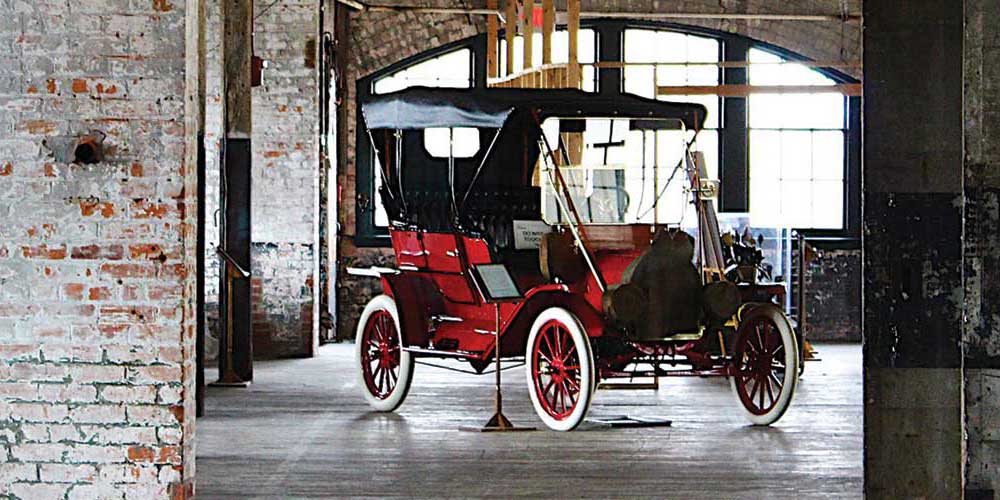By Robert Tate, Automotive Historian and Researcher
Images courtesy of the National Automotive History Collection and General Motors’ Media
Posted: 06.05.2017
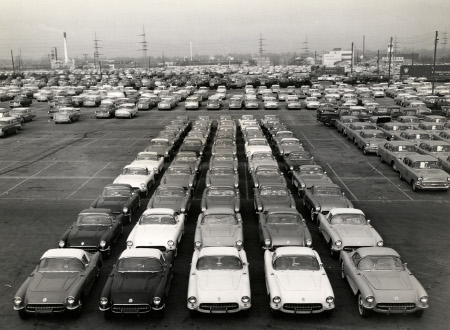 Production models for the 1957 Corvette.Throughout automotive history, the iconic Corvette by General Motors has been a symbol for superior auto performance that enthusiasts and collectors have enjoyed since its birth in 1953. Even today, the Corvette is one of the most admired American sports cars in our country.
Production models for the 1957 Corvette.Throughout automotive history, the iconic Corvette by General Motors has been a symbol for superior auto performance that enthusiasts and collectors have enjoyed since its birth in 1953. Even today, the Corvette is one of the most admired American sports cars in our country.
The Corvette has had a massive following since its introduction. From Harley Earl and Bill Mitchell to, more recently, Chuck Jordan and Ed Welburn, the Corvette’s sleek and windswept styling has held a special place in the hearts of automotive enthusiasts – especially those who like speed. All of the aforementioned past vice presidents of the General Motors design staff developed and had given fans great styling for generations.
It was the legendary Harley Earl, however, who in the beginning worked privately with a hand-picked crew in the Body Development Studio to make this dream car a reality for the world to see and enjoy. From creative sketching to a basic layout, the first Corvette took shape with its world-class design team hovering over every detail. One of the first designers tapped for the Corvette project studio was the late Robert F. McLean, who was a Cal Tech graduate with degrees in both engineering and industrial design. At the start, one of Harley Earl's biggest concerns for Corvette production was to keep the cost down to a minimum so it would be affordable for the consumer market.
Earl had also envisioned new popularity for sports car racing throughout America. This story highlights some of the Corvette portraits that have been ingratiated into automotive heritage.
The 1950s Corvette models introduced power and speed as well as great styling that most Americans thoroughly had enjoyed. For example in 1957, the Corvette models offered a fuel injected 283 cubic-inch engine that could be ordered by the consumer. The models were available in six solid colors and six two-tone combinations.
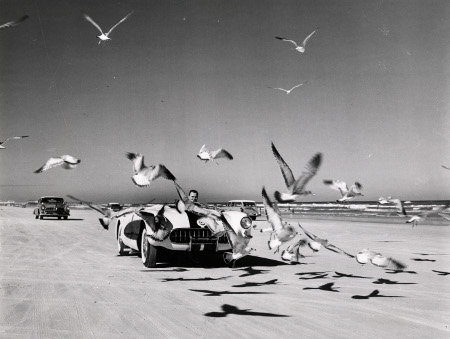 1956 Corvette at Dayton Beach, Fla.One of the Corvette images, that is a part of this story, highlights a speedy 1956 Corvette converging at Daytona Beach, Florida, during the NASCAR Speed Weeks. As you can see in the photo, the driver was on his way to the speed trail area when he encountered a group of hungry sea gulls.
1956 Corvette at Dayton Beach, Fla.One of the Corvette images, that is a part of this story, highlights a speedy 1956 Corvette converging at Daytona Beach, Florida, during the NASCAR Speed Weeks. As you can see in the photo, the driver was on his way to the speed trail area when he encountered a group of hungry sea gulls.
Another interesting photograph highlights this story by showing a large shipment of 1957 Corvette models equipped with exclusive Ramjet fuel injection (See top photo). They were destined for all parts of the country where demand for the model had far exceeded the supply. The fuel injection, which was engineered by Chevrolet in its 1957 line, had replaced the conventional carburetor assuring a quicker, smoother accelerator response for the driver.
Another name who gets overlooked in the pantheon of Corvette design is the late Zora Arkus Duntov, who worked on and developed many of the GM-Corvette projects.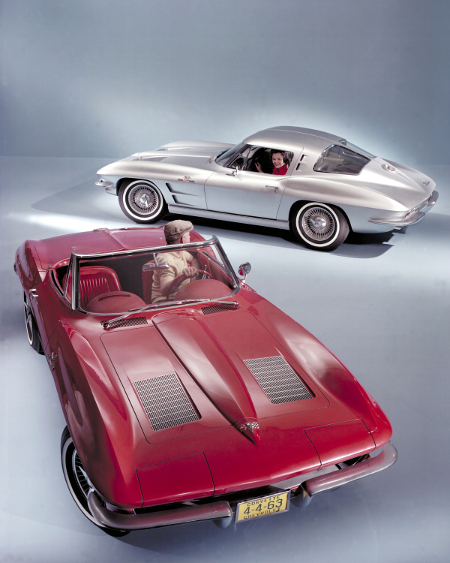 1963 CorvettesIn the early 1960s, Corvette developed a new Corvette design model called the XP-720. The only components that were carried over without major changes to the new XP-720, or 1963 Corvette model, were the engine and drive train combinations.
1963 CorvettesIn the early 1960s, Corvette developed a new Corvette design model called the XP-720. The only components that were carried over without major changes to the new XP-720, or 1963 Corvette model, were the engine and drive train combinations.
Zora Duntov and his team of talented engineers, such as Harold Krieger and Walter Zetye, were a part of the developing engineering stages for the all-new 1963 Corvette split window design. The late Bill Mitchell along with Larry Shinoda and the 1963 design team, had changed the appearance for those year models. The 1963 Corvette models offered that sharp split window body edge design that many consumers really enjoyed. 1969 CorvetteIn 1968, General Motors introduced a new body design for Corvette, which was a great looking model. The 1968 Corvette models offered the consumer removable panels in the roof area and a tunnel rear window design that was very different from other sports models at the time.
1969 CorvetteIn 1968, General Motors introduced a new body design for Corvette, which was a great looking model. The 1968 Corvette models offered the consumer removable panels in the roof area and a tunnel rear window design that was very different from other sports models at the time.
Although the 1963-67 Stingray models are considered the classic Corvettes of the 1960s, the 1968-1970 models were more successful within the consumer market.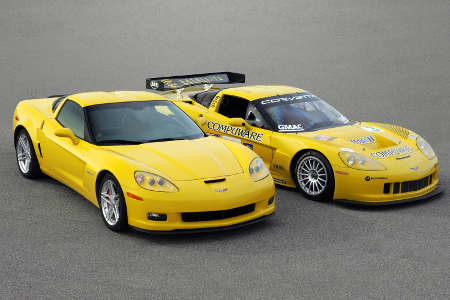 2005-2006 CorvettesAlthough quote different looking compared to models being produced in the 1960s, the 2005-06 Corvette models continue to hold onto that super sporty and power-branded design. Featured in this story are the 2006 Chevrolet Corvette Z06 and the 2005 Chevrolet Corvette C6-R race car (below). The Chevrolet Corvette C5 R race car was also very popular among professional drivers.
2005-2006 CorvettesAlthough quote different looking compared to models being produced in the 1960s, the 2005-06 Corvette models continue to hold onto that super sporty and power-branded design. Featured in this story are the 2006 Chevrolet Corvette Z06 and the 2005 Chevrolet Corvette C6-R race car (below). The Chevrolet Corvette C5 R race car was also very popular among professional drivers.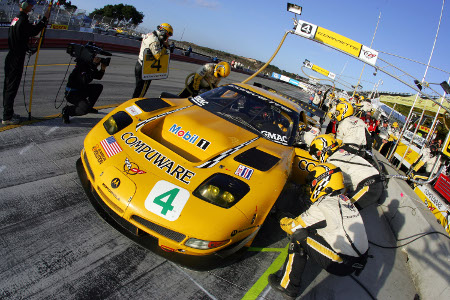 2005 Corvette C6-R race carToday, the Chevrolet Corvette has retained its great style and heritage with the introduction 2017 Corvette Grand Sport model. Another great designer that is a part of Corvette’s history and legacy is the talented Tom Peters.
2005 Corvette C6-R race carToday, the Chevrolet Corvette has retained its great style and heritage with the introduction 2017 Corvette Grand Sport model. Another great designer that is a part of Corvette’s history and legacy is the talented Tom Peters.
In conclusion, General motors said this about the new Grand Sport “The all-new 2017 Corvette Grand Sport combines an aggressive suspension, performance technologies and aerodynamics package with a naturally aspirated engine for incredible grip and handling.”
For further information on photos please visit http://www.detroitpubliclibrary.org/ or email This email address is being protected from spambots. You need JavaScript enabled to view it.. Please do not republish the story and/or photographs without permission of MotorCities National Heritage Area. (Bibliography: Dammann H., George. “Sixty Years of Chevrolet” Crestline Publishing 1972. Ludvigsen Karl. “Corvette America's Star-Spangled Sports Car the Complete History “Automobile Quarterly publications. 1973-1974. General Motors Media On-line website. Photography & CD-Rom.2006.)
If you would like to contribute an article for the MotorCities newsletter, email This email address is being protected from spambots. You need JavaScript enabled to view it. or call 313-259-3425.


